
Liriodendron is a genus of two species of characteristically large trees, deciduous over most of their populations, in the magnolia family (Magnoliaceae).

William Kirby was an English entomologist, an original member of the Linnean Society and a Fellow of the Royal Society, as well as a country rector, so that he was an eminent example of the "parson-naturalist". The four-volume Introduction to Entomology, co-written with William Spence, was widely influential.

Goji, goji berry, or wolfberry is the fruit of either Lycium barbarum or Lycium chinense, two closely related species of boxthorn in the nightshade family, Solanaceae. L. barbarum and L. chinense fruits are similar but can be distinguished by differences in taste and sugar content.

Capsicum chinense, commonly known as a "habanero-type pepper", is a species of chili pepper native to the Americas. C. chinense varieties are well known for their unique flavors and many have exceptional heat. The hottest peppers in the world are members of this species, with Scoville Heat Unit scores of over 2 million. Some taxonomists consider them to be part of the species C. annuum, and they are a member of the C. annuum complex; however, C. chinense and C. annuum pepper plants can sometimes be distinguished by the number of flowers or fruit per node – two to five for C. chinense and one for C. annuum – though this method is not always correct. The two species can also hybridize and generate inter-specific hybrids. It is believed that C. frutescens is the ancestor to the C. chinense species.
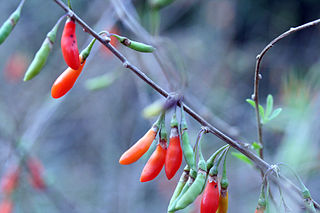
Lycium chinense is one of two species of boxthorn shrub in the family Solanaceae. Along with Lycium barbarum, it produces the goji berry ("wolfberry"). Two varieties are recognized, L. chinense var. chinense and L. chinense var. potaninii. It is also known as Chinese boxthorn, Chinese matrimony-vine, Chinese teaplant, Chinese wolfberry, wolfberry, and Chinese desert-thorn.
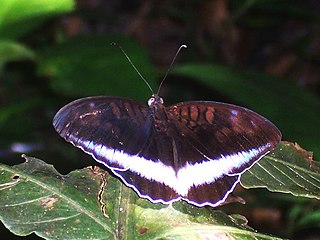
The Limenitidinae are a subfamily of butterflies that includes the admirals and relatives. The common names of many species and genera reference military ranks or – namely the Adoliadini – titles of nobility, in reference to these butterflies' large size, bold patterns, and dashing flight. In particular, the light stripe running lengthwise across the wings of many Limenitidini has reminded earlier authors of officers' shoulder marks and epaulets.

Liriodendron chinense is Asia's native species in the genus Liriodendron. This native of central and southern China grows in the provinces of Anhui, Guangxi, Jiangsu, Fujian, Guizhou, Hubei, Hunan, Jiangxi, Shaanxi, Zhejiang, Sichuan and Yunnan, and also locally in northern Vietnam. Protected populations occur in the Tianmushan National Reserve, Huangshan, Wuyi Shan, and Badagongshan Nature Reserve.
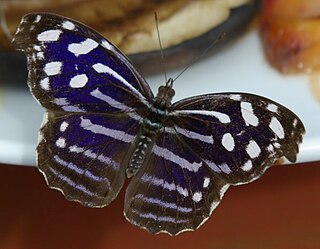
Biblidinae is a subfamily of nymphalid butterflies that includes the tropical brushfoots. This subfamily was sometimes merged within the Limenitidinae, but they are now recognized as quite distinct lineages. In older literature, this subfamily is sometimes called Eurytelinae.
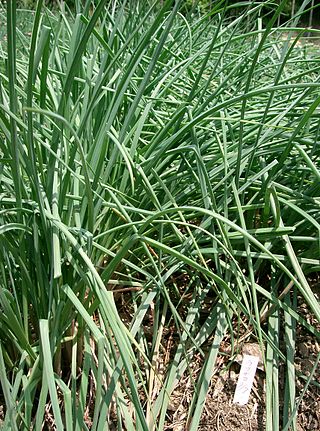
Allium chinense is an edible species of Allium, native to China, and cultivated in many other countries. Its close relatives include the onion, shallot, leek, chive, and garlic.

Calosoma sycophanta, the forest caterpillar hunter, is a species of ground beetle belonging to the family Carabidae.

Loropetalum chinense is commonly known as loropetalum, Chinese fringe flower and strap flower. Two forms of L. chinense exist; a white- flowering green-leafed variety and a pink-flowering variety with leaves varying from bronze-red when new to olive-green or burgundy when mature, depending on selection and growing conditions.
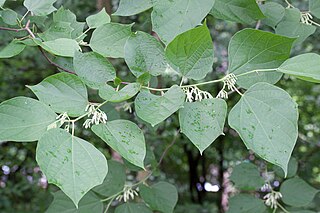
Alangium chinense is a species of flowering plant in the Cornaceae family. It has the Chinese name.

Calosoma is a genus of large ground beetles that occur primarily throughout the Northern Hemisphere, and are referred to as caterpillar hunters or caterpillar searchers. Many of the 167 species are largely or entirely black, but some have bright metallic coloration. They produce a foul-smelling spray from glands near the tip of the abdomen. They are recognizable due to their large thorax, which is almost the size of their abdomen and much wider than their head.

Calosoma inquisitor is a species of ground beetle. The species is found in northern Africa, Europe and East to Asia Minor, Iran and the Caucasus, with isolated populations in eastern Siberia and Japan.

Isocoumarin is a lactone, a type of natural organic compound.

Calosoma frigidum, also known as the cold-country caterpillar hunter, is a species of ground beetle in the subfamily Carabinae. It was first described by William Kirby in 1837. Occurring throughout southern Canada and the United States, it is about 16mm to 27mm long and black, with rows of pits or dots along its elytra. These pits are an iridescent blue/green, and larger than the pits of many other Calosoma species. It can be found in wooded areas and is active at night, while hiding under debris by day.

Iris ser. Chinenses is a series of the genus Iris, in Iris subg. Limniris.
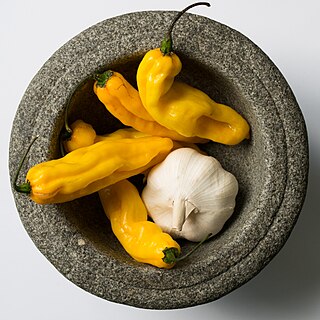
Madame Jeanette is a chili pepper cultivar of the species Capsicum chinense, originally from Suriname.

















